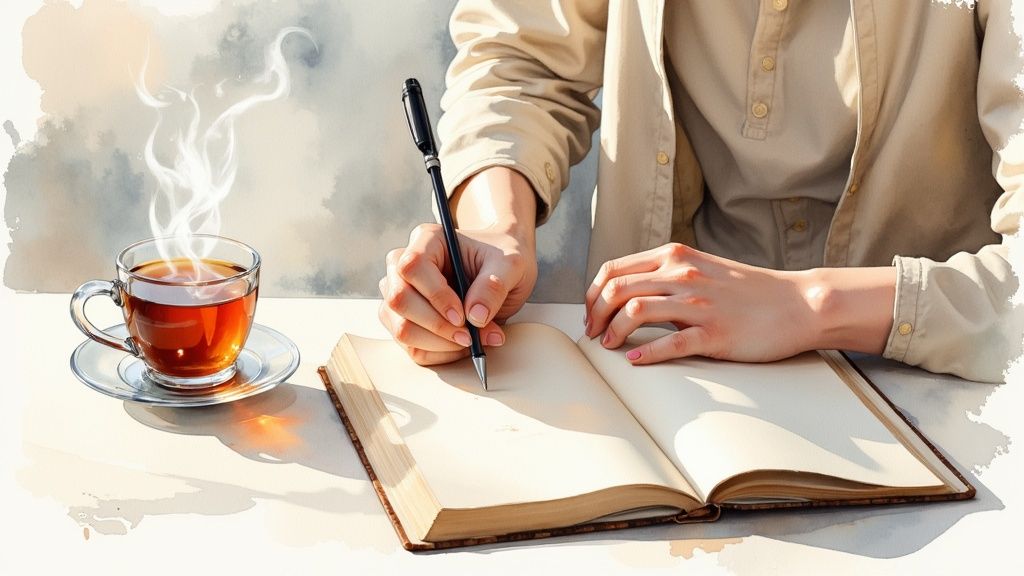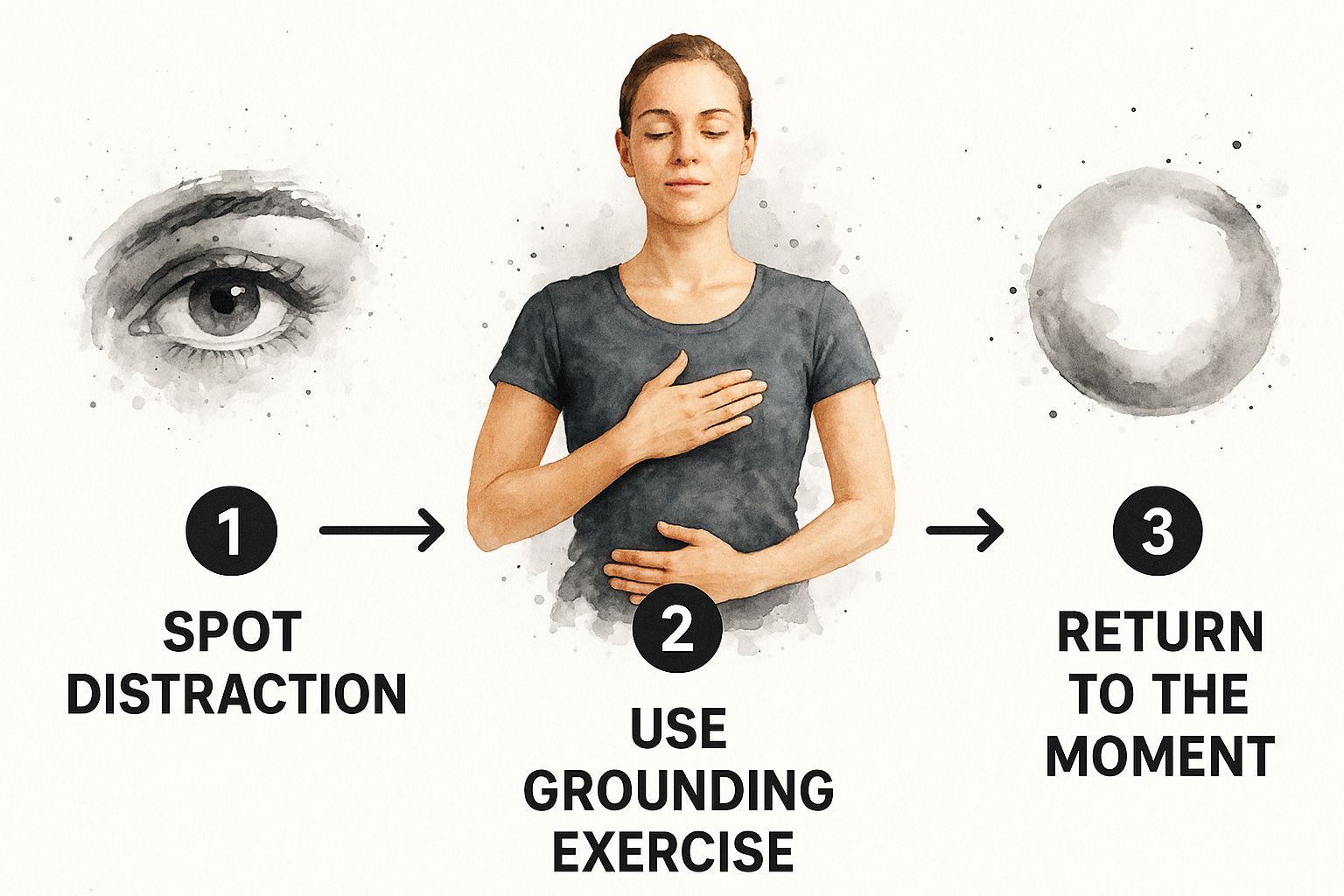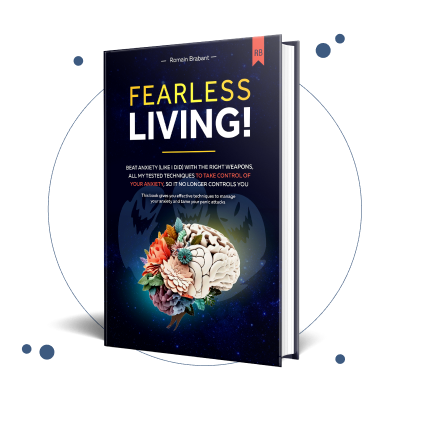
Being present just means tuning into what’s happening right now, instead of getting tangled up in yesterday’s regrets or tomorrow’s worries. It’s a skill, and it’s one of the most powerful anchors you can have, offering hope and a practical path toward healing from anxiety and living a life free from panic.
Your Path From Anxiety to Presence Starts Here
If you feel trapped in a nonstop cycle of anxious thoughts, you are definitely not alone. Living with anxiety often feels like your mind is a runaway train, speeding toward countless "what-if" scenarios that leave you feeling drained and overwhelmed. It's like being stuck in a constant state of high alert, with your nervous system braced for a threat that never actually shows up.
This guide is built on a simple but profound truth: you have the power to step off that train and heal. The practice of being present in the moment isn't some abstract, mystical concept; it's a lifeline. It's about learning how to gently shift your focus from the storm swirling inside your mind to the solid ground right beneath your feet, showing you that a panic-free life is possible.
Finding Your Anchor in the Now
Think about someone like Sarah, an office worker whose days were once dictated by a deep-seated fear of panic attacks. Every meeting felt like a potential trigger, and every quiet moment was an invitation for catastrophic thoughts to rush in. Her mind was always one step ahead, mentally mapping out escape routes from situations that hadn't even happened yet.
Her turning point came when she learned to anchor herself in the "now." Instead of fighting off the anxious thoughts, she started to simply notice the feeling of her feet on the floor, or the warmth of her coffee cup in her hands. These small acts of presence became her secret weapon. They didn't magically erase her anxiety, but they carved out precious moments of calm, proving to her that she could find stability and that healing was truly possible.
This is the core of healing: realizing that your anxious thoughts are just visitors, not permanent residents. By practicing presence, you learn to acknowledge them without letting them take over, and you reclaim your peace.
This guide provides a clear roadmap to help you do the same. It’s designed to give you practical skills and real, actionable steps, all while setting a tone of hope and assurance. We’ll explore how you can cultivate this ability and begin your own journey toward a calmer, more grounded life. For those looking for a structured approach, understanding the core anxiety recovery steps can provide a valuable framework for this process.
You can heal your relationship with anxiety, and it starts today.
What Does Being Present Really Mean?

Let's cut through the noise and get real about what "being present" actually means. Imagine your anxious mind is a small boat caught in a stormy sea, getting tossed around by waves of worry about the future and regrets from the past. Being present in the moment is the anchor that holds you steady, offering a tangible way to not just cope with anxiety, but to truly heal from it.
It’s not about ignoring your problems or pretending they don’t exist. Far from it. It’s about consciously shifting your awareness from the turbulent waters of your thoughts to the solid, unshakeable reality of right now. This is the crucial difference between just passively existing while your mind runs wild and actively building a panic-free life.
This simple shift is a powerful tool against anxiety. Anxiety thrives on "what-ifs" and "should-haves," pulling you out of the only place you have any real control: the present. By intentionally focusing on the now, you essentially cut off anxiety’s fuel supply.
You Are Not Your Anxious Thoughts
A core idea that unlocks this entire practice is understanding that you are not your thoughts. Anxious feelings and racing thoughts are events that happen within you, but they don't define who you are. Think of them as clouds passing through the vast, open sky of your consciousness.
You are the sky, not the clouds. By practicing presence, you learn to observe these anxious thoughts from a distance without getting swept up in their story. This creates a small but powerful space between you (the observer) and your anxiety.
In that space lies your power to heal. When you can watch an anxious thought arise without immediately reacting to it, you strip it of its urgency and control. It becomes just a thought—not an undeniable truth that dictates your reality.
This separation is the foundation for lasting change. It shows you that even when anxiety is present, a part of you can remain calm and grounded. It’s not just a nice idea, either. Research into mindfulness backs this up, showing that the practice can reduce anxiety by 30% within two months—an impact comparable to some conventional medications and a clear sign of hope for recovery.
Anchoring Yourself in Tangible Reality
So, how do you find this anchor? It starts with your senses. Instead of getting lost in your mind, you can consciously tune into what you can see, hear, touch, taste, and smell right now. This is a foundational element of many grounding techniques for anxiety, which act as a direct line back to the present moment.
Each time you bring your attention to the feeling of your feet on the floor or the sound of birds outside, you are practicing this skill. You are training your mind to return to the safety of the present, moment by moment. It's not about achieving perfection, but about gently and repeatedly guiding yourself back home to the now. This is the path to living panic-free.
The Science of How Presence Heals Anxiety

Practicing presence isn’t some abstract wellness concept; it’s a hands-on way to physically rewire your brain for calm and create a future free from panic.
If you live with chronic anxiety, you know what it’s like to have your body’s internal alarm system—the famous “fight or flight” response—stuck in the “on” position. Being in that constant state of high alert is utterly exhausting and lies at the root of so many physical and emotional symptoms.
Think of being present in the moment as the master switch that can finally turn that alarm off. It sends a direct, powerful signal to your body that you are safe right here, right now, giving your nervous system the permission it needs to stand down. This isn't just wishful thinking; it’s a biological process with real, measurable effects that pave the way for healing.
Calming Your Brain’s Fear Center
Tucked deep inside your brain is the amygdala, a tiny, almond-shaped structure that acts as your personal threat detector. When you're anxious, your amygdala is working overtime, constantly scanning for danger and hitting the panic button even when there’s no real threat in sight.
Practicing mindfulness directly soothes this overactive fear center. Brain imaging studies have shown that a consistent mindfulness practice can actually shrink the amygdala and reduce its activity. This means that by repeatedly guiding your attention back to the present moment, you are actively training your brain to be less reactive and more peaceful.
Each time you choose to focus on your breath instead of a racing thought, you are actively weakening the neural pathways that fuel panic and strengthening the ones that create calm. This is the foundation of healing and your path to a life without constant fear.
Strengthening Your Rational Mind
At the same time, being present strengthens another key part of your brain: the prefrontal cortex. Located right behind your forehead, this area is the "CEO" of your brain, responsible for rational thinking, emotional regulation, and decision-making. It’s the part that can step in and override the amygdala’s primal fear signals.
When you practice presence, you’re essentially building a stronger, faster connection between your calm, rational prefrontal cortex and your hair-trigger amygdala. This improved communication allows you to respond to stress with clarity instead of reacting with automatic panic. To get a better handle on this biological process, you can learn more about the fight-or-flight response in our guide.
This process reveals that healing from anxiety isn’t just about willpower; it’s about physically changing your brain’s structure and function. Even our external environment plays a role, as explored in discussions on the neuroscience of decluttering for mental health. By committing to this practice, you’re giving yourself a scientifically-backed tool to build resilience, find your footing, and create a lasting sense of peace.
Practical Exercises to Find Your Calm
Knowing about presence is one thing, but actually practicing it is where the real healing happens. Think of this as your toolkit—a set of simple, powerful exercises you can use right away to ground yourself and build a panic-free foundation.
These aren’t complicated rituals. They’re practical tools designed for real life, whether you’re at your desk, in a crowded store, or smack in the middle of a stressful meeting. The goal is to take back control, one moment at a time.
And you're not alone in this. As of 2025, over 275 million people worldwide practice meditation, a core skill for building presence. That number is skyrocketing—meditation use among U.S. adults jumped from just 4.1% in 2012 to 14.2% in 2017. It's a clear sign that more and more people are discovering just how much this helps.
The 5-4-3-2-1 Grounding Technique
When panic feels like it’s about to take over, the 5-4-3-2-1 technique is your emergency brake. It yanks your focus out of the storm inside your head and plants it firmly in the physical world. It’s so effective because it forces you to engage your senses, making it nearly impossible for anxious thoughts to keep their grip.
Here’s how it works:
- Look for 5 things you can see. Name five separate objects around you. Don't judge them, just notice them—a pen on your desk, a crack in the ceiling, a reflection in your screen.
- Acknowledge 4 things you can feel. Bring your awareness to physical sensations. It could be the texture of your shirt, the solid ground under your feet, or the cool surface of a table.
- Listen for 3 things you can hear. Tune into the sounds around you, both close and far away. Maybe it's the hum of your computer, the sound of traffic outside, or your own breathing.
- Notice 2 things you can smell. This one might take a little more focus. Can you smell the faint scent of coffee, soap on your hands, or just the air in the room?
- Identify 1 thing you can taste. Focus on one taste, even if it's just the neutral sensation inside your mouth. Taking a sip of water can help with this step.
Mindful Breathing for Daily Calm
Your breath is the most reliable anchor you have because it’s always there. Mindful breathing is a simple but profound way to settle your nervous system and carve out moments of peace throughout your day.
Unlike the 5-4-3-2-1 method, which is for high-stress moments, this is a practice you can build over time to create a steady foundation of calm and hope.
Just find a comfortable spot and bring your attention to your breath. Feel the air coming in through your nose, filling your lungs, and then leaving your body. You don't need to change anything—just observe. For a deeper dive, check out our complete guide to breathing exercises for anxiety.
This gentle return to the breath, over and over again, is a powerful act of self-compassion. It teaches your mind that it’s okay to let go of worries and simply be. It is a promise of peace that you can give yourself anytime.
Distractions are guaranteed to pop up. The infographic below offers a simple plan for what to do when they do.

The key isn't to fight off distractions, but to gently guide your focus back each time they appear. This reinforces your ability to stay grounded, no matter what’s going on around you.
The Mindful Body Scan
Ever feel detached or disconnected when anxiety hits? A body scan is the perfect way to get back in touch with yourself. The exercise involves bringing a gentle, non-judgmental awareness to different parts of your body, one by one. It’s a fantastic way to release tension you didn't even know you were holding onto.
Start by lying down or sitting somewhere comfortable. Close your eyes and bring your attention all the way down to your toes. Notice any sensations—warmth, coolness, tingling—without trying to change them.
From there, slowly move your awareness up through your feet, ankles, legs, and the rest of your body, all the way to the top of your head. It’s a practice that reminds you that you can find peace right inside your own skin.
Sometimes you need a quick tool for a specific situation. This table can help you pick the right exercise for the moment.
Mindfulness Exercises for Different Situations
| Situation | Recommended Exercise | Primary Goal |
|---|---|---|
| Feeling overwhelmed or panicky | 5-4-3-2-1 Grounding | Immediately anchor yourself in the present moment |
| Need a quick reset during the day | Mindful Breathing | Calm the nervous system and find a moment of peace |
| Feeling disconnected from your body | Mindful Body Scan | Reconnect with physical sensations and release tension |
| Caught in a negative thought loop | Mindful Breathing | Break the cycle by shifting focus to a neutral anchor |
| Waiting in line or in transit | 5-4-3-2-1 Grounding | Engage with your surroundings instead of your phone |
Think of these exercises as a menu of options. You don't have to do them all; just choose the one that feels right for what you're experiencing.
Weaving Presence Into Your Daily Routine
Real healing from anxiety doesn't just happen in scheduled ten-minute meditation slots. The kind of change that sticks comes when being present in the moment becomes a natural part of your day, woven right into the fabric of your life. It’s about turning the most mundane activities into powerful chances to find calm and reconnect with yourself.
That shift in perspective is everything. Instead of seeing mindfulness as another chore on your to-do list, you start to see it as a different way of living. It’s not about adding more to your plate; it’s about changing how you experience what’s already there.
Turning Everyday Actions Into Mindful Moments
You don’t need a special cushion or a silent room to practice being present. Honestly, your daily routine is already packed with opportunities to anchor yourself in the now. The goal is simple: gently guide your focus to one thing, just for a moment, giving your mind a much-needed break from the hamster wheel of anxious thoughts.
Here are a few simple ways to get started:
- Mindful Coffee: When you’re having your morning coffee or tea, just for a minute, do nothing else. Pay full attention to the warmth of the mug in your hands, the rich smell, and the actual taste of each sip.
- Mindful Walking: As you walk to your car or just down the hallway, notice the sensation of your feet hitting the ground. Feel the rhythm of your steps and the subtle movements of your body.
- Single-Tasking: At work, fight the urge to multitask. When you’re writing an email, just write the email. When you’re on a call, just listen. This focus dials down the overwhelm and brings a sense of clarity.
By sprinkling these small acts of awareness throughout your day, you're constantly sending little signals of safety to your nervous system. Each mindful moment is a small win, reinforcing your ability to stay grounded and calm.
Overcoming Common Hurdles with Compassion
As you start trying this, it’s completely normal to run into challenges. You might forget to be mindful for an entire day, or you might get frustrated when your mind wanders off for the tenth time in a minute. This isn't a sign you're failing; it's just part of the process.
The most important thing is to meet these moments with self-compassion, not judgment. Simply notice you got distracted, and gently begin again. Every single time you bring yourself back to the present, you're strengthening your resilience. Pairing this with other positive habits, like journaling, can be incredibly effective. To learn more, check out our guide on how a gratitude journal can reduce anxiety.
This approach is proving its worth, even in high-stress environments. Data from workplaces shows how being present through meditation can boost performance and slash stress. Among employees who meditate at work, a staggering 86% report improved focus, and 82% notice reduced stress levels. Globally, 92% of meditators say stress relief is their main reason for practicing.
This whole journey is about building a new relationship with yourself and your mind, one gentle, present moment at a time. It offers real hope that you can heal from anxiety and start living a life that isn't dictated by panic.
Got Questions About Being Present?
Starting this journey always brings up a few questions. That's perfectly normal. The goal here is to give you clear, encouraging answers that get rid of any roadblocks and drive home the main point: there’s a real, achievable way to heal from anxiety and live panic-free.
How Long Does It Take to Feel a Difference?
While grounding techniques can bring you back from the edge during a panic attack, the real, lasting change comes from consistency. Many people say they feel a real shift in their day-to-day anxiety within just a few weeks of practicing for 5-10 minutes a day.
Bigger, more fundamental changes—like shifting your gut reaction to stress—usually start to kick in after about two months. Remember, this isn't about being perfect. It's about gentle, consistent practice. Every single time you bring yourself back to the present, you're building a new foundation for a calmer life.
The best part of this whole thing is that healing isn't some far-off destination. It’s happening right now, in the small, quiet moments you snatch back from anxiety. You're proving to yourself, over and over, that you can find your own calm.
This steady effort is what rewires your brain for peace. It’s how you build a life that isn’t just a dream, but a reality you're creating, moment by moment.
What If I Can’t Stop My Anxious Thoughts?
This is probably the most common question I hear, and the answer is a huge relief: you don’t have to. The point of being present isn't to force your mind into silence. That's an impossible goal that just adds more stress to the pile.
Instead, the goal is to change your relationship with your thoughts.
Picture yourself sitting on the bank of a river. Your anxious thoughts are like leaves floating by on the water. Before, you might have jumped in and tried to grab every single leaf, getting pulled under by the current. Now, you’re just learning to sit and watch them drift past.
You notice the thought, you acknowledge it ("Ah, there's that worry again"), and then you let it go, gently pulling your focus back to your breath or the feeling of your feet on the floor. This simple act of observing without getting tangled up is what robs anxiety of its power. Each time you do it, you reinforce a powerful truth: you are the observer, not the thoughts themselves.
Do I Need to Meditate for Hours to See Results?
Absolutely not. That’s a huge myth that stops a lot of people before they even start. Long meditation sessions can be great, but the real magic for healing anxiety comes from weaving tiny moments of presence into the life you’re already living.
Think of it like building a new muscle. You wouldn't hit the gym for three hours once a week and expect to see changes. You'd build strength with shorter, more frequent workouts. It's the exact same idea here.
- Take one minute for mindful breathing while the coffee is brewing.
- Spend three minutes just noticing the sounds around you while you sit at your desk.
- Do a thirty-second body scan while you're waiting in line.
These little "micro-practices" are incredibly powerful for calming your nervous system throughout the day. They're way more sustainable—and ultimately more effective—than trying to carve out a huge chunk of uninterrupted time. Start small. Every moment really does count on your journey to a panic-free life.
If you're ready to turn these ideas into a clear, step-by-step plan for real relief, The Anxiety Checklist is where you should head next. Our Fearless Living system gives you the tools to manage anxiety, handle panic attacks, and finally start living the life you deserve. Don't just wish for a better future—start building it today at https://anxietychecklist.com.

